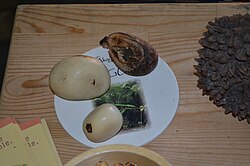– Location:
– Tagua nut carving reveals the grain on the top.
– Species in the genus Phytelephas are the main sources of vegetable ivory.
– Other sources include seeds from the Caroline ivory-nut palm, natangura palm, and real fan palm.
– A tagua palm takes up to 15 years to mature and can produce vegetable ivory for up to 100 years.
– In a year, a tagua palm can yield up to 20 pounds of vegetable ivory.
– Species:
– Phytelephas macrocarpa is mainly found in Peru and Bolivia.
– Phytelephas aequatorialis is mainly harvested in Ecuador.
– Phytelephas seemannii is primarily sourced from Colombia.
– Phytelephas tenuicaulis.
– Uses:
– Vegetable ivory was traditionally used for making buttons.
– Before plastic, 20% of US buttons were made from vegetable ivory.
– It is also used for dice, knife handles, and chess pieces due to its hardness.
– Carving vegetable ivory requires hacksaws and files.
– Natural tagua nut color was often used as a contrast in decoration.
– References:
– Sentance & Sentance’s book “Craft Traditions of the World” provides insights on vegetable ivory.
– Waynes Word archive discusses vegetable ivory.
– “10 Reasons to Love the Tagua Nut!” from Life Less Ordinary.
– Grischa Brokamp’s work on wild plant collection in NW South America.
– John M. Ives’ publication “Rochester, 1906” by Rochester Chamber of Commerce.
– Additional Information:
– Sentance & Sentance’s book “Craft Traditions of the World” provides insights on vegetable ivory.
– Waynes Word archive discusses vegetable ivory.
– “10 Reasons to Love the Tagua Nut!” from Life Less Ordinary.
– Grischa Brokamp’s work on wild plant collection in NW South America.
– John M. Ives’ publication “Rochester, 1906” by Rochester Chamber of Commerce.
Vegetable ivory or tagua nut is a product made from the very hard white endosperm of the seeds of certain palm trees. Vegetable ivory is named for its resemblance to animal ivory. Vegetable ivory is naturally white with a fine marbled grain structure. It can be dyed; dyeing often brings out the grain. It is still commonly used in buttons, jewelry, and artistic carving.

